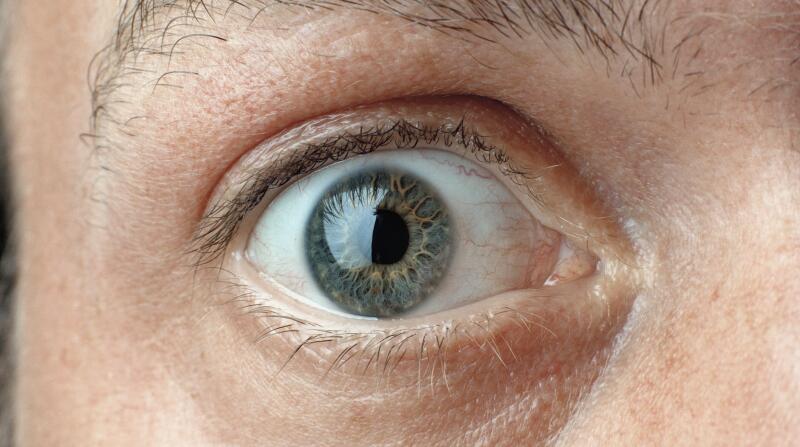8 Things to Know About Graves' Disease

Medically Reviewed By William C. Lloyd III, MD, FACS
Written By Jennifer L.W. Fink, RN, BSN on December 24, 2020
-
 Do you know these Graves’ disease facts?Approximately 1 in 200 Americans has Graves’ disease, an autoimmune disorder that causes the thyroid to pump out an excess of thyroid hormone. The thyroid is a small gland located at the base of your neck. When it’s working well, you’re probably not even aware of its existence. But when it goes into overdrive, you can experience disturbing symptoms, including a racing heart, difficulty sleeping, diarrhea, and an abundance of nervous energy.
Do you know these Graves’ disease facts?Approximately 1 in 200 Americans has Graves’ disease, an autoimmune disorder that causes the thyroid to pump out an excess of thyroid hormone. The thyroid is a small gland located at the base of your neck. When it’s working well, you’re probably not even aware of its existence. But when it goes into overdrive, you can experience disturbing symptoms, including a racing heart, difficulty sleeping, diarrhea, and an abundance of nervous energy. -
 1. Weight loss can be a symptom of Graves’ disease.Graves’ disease symptoms include irregular heartbeat, heat sensitivity, shaky hands, muscle weakness, irritability, and bulging eyes. Unexpected weight loss can also be a symptom of Graves’ disease, as excess thyroid hormone speeds up the body’s metabolism. If you are losing weight without effort, see a healthcare provider. Your provider can perform a physical exam and run some tests to see if you have Graves’ disease or another medical condition.
1. Weight loss can be a symptom of Graves’ disease.Graves’ disease symptoms include irregular heartbeat, heat sensitivity, shaky hands, muscle weakness, irritability, and bulging eyes. Unexpected weight loss can also be a symptom of Graves’ disease, as excess thyroid hormone speeds up the body’s metabolism. If you are losing weight without effort, see a healthcare provider. Your provider can perform a physical exam and run some tests to see if you have Graves’ disease or another medical condition. -
-
 2. Graves’ disease affects more women than men.Graves’ disease is seven to eight times more common in women than men. The disease often affects women between the ages of 30 and 60. Women who have another autoimmune disorder (such as lupus, rheumatoid arthritis, or type 1 diabetes) or a family history of Graves’ disease are at increased risk for Graves’ disease. A woman’s risk is also elevated after giving birth. The risk of developing Graves’ disease is seven times higher than usual during the year following a birth, according to the National Institute of Diabetes and Digestive and Kidney Diseases.
2. Graves’ disease affects more women than men.Graves’ disease is seven to eight times more common in women than men. The disease often affects women between the ages of 30 and 60. Women who have another autoimmune disorder (such as lupus, rheumatoid arthritis, or type 1 diabetes) or a family history of Graves’ disease are at increased risk for Graves’ disease. A woman’s risk is also elevated after giving birth. The risk of developing Graves’ disease is seven times higher than usual during the year following a birth, according to the National Institute of Diabetes and Digestive and Kidney Diseases. -
 3. Graves’ disease can cause pregnancy complications.Untreated or under-treated Graves’ disease can cause preeclampsia (a potentially fatal condition characterized by high blood pressure), placental abruption (the untimely separation of the placenta from the wall of the uterus), miscarriage, stillbirth, or premature birth. It can also cause problems in the developing baby, including a rapid heart rate, low birth weight, and abnormal thyroid function. Adequate treatment of Graves’ disease can prevent these complications. If you have Graves’ disease, it’s a good idea to talk with your healthcare provider before trying to conceive.
3. Graves’ disease can cause pregnancy complications.Untreated or under-treated Graves’ disease can cause preeclampsia (a potentially fatal condition characterized by high blood pressure), placental abruption (the untimely separation of the placenta from the wall of the uterus), miscarriage, stillbirth, or premature birth. It can also cause problems in the developing baby, including a rapid heart rate, low birth weight, and abnormal thyroid function. Adequate treatment of Graves’ disease can prevent these complications. If you have Graves’ disease, it’s a good idea to talk with your healthcare provider before trying to conceive. -
 4. Bulging eyes are a symptom of Graves’ ophthalmopathy.Approximately 30 to 50% of people with Graves’ disease develop a condition called Graves’ ophthalmopathy, also referred to as thyroid eye disease or Graves' eye disease. The primary symptom of Graves’ ophthalmopathy is bulging eyes caused by swelling of one or more of the six muscles that turn the eye. Other symptoms include eye irritation, double vision, light sensitivity, difficulty moving the eyes, and eye pressure or pain. Without treatment, Graves’ ophthalmopathy can cause severe eye discomfort and even vision loss, although this is rare. Your healthcare provider can recommend medication, surgery, and other strategies to improve comfort and vision. In many people, the symptoms of Graves’ ophthalmopathy improve with time.
4. Bulging eyes are a symptom of Graves’ ophthalmopathy.Approximately 30 to 50% of people with Graves’ disease develop a condition called Graves’ ophthalmopathy, also referred to as thyroid eye disease or Graves' eye disease. The primary symptom of Graves’ ophthalmopathy is bulging eyes caused by swelling of one or more of the six muscles that turn the eye. Other symptoms include eye irritation, double vision, light sensitivity, difficulty moving the eyes, and eye pressure or pain. Without treatment, Graves’ ophthalmopathy can cause severe eye discomfort and even vision loss, although this is rare. Your healthcare provider can recommend medication, surgery, and other strategies to improve comfort and vision. In many people, the symptoms of Graves’ ophthalmopathy improve with time. -
 5. Smoking increases your risk of Graves’-related visual problems.Cigarette smoking and exposure to tobacco smoke increases your risk of developing Graves’ disease—and Graves’ ophthalmopathy. If you have been diagnosed with Graves’ disease, you can decrease your risk of developing eye and vision problems by quitting smoking. People who have already developed visual problems can improve their prognosis by quitting smoking. Staying away from cigarettes, cigars, and secondhand smoke is your best bet for healthy eyes.
5. Smoking increases your risk of Graves’-related visual problems.Cigarette smoking and exposure to tobacco smoke increases your risk of developing Graves’ disease—and Graves’ ophthalmopathy. If you have been diagnosed with Graves’ disease, you can decrease your risk of developing eye and vision problems by quitting smoking. People who have already developed visual problems can improve their prognosis by quitting smoking. Staying away from cigarettes, cigars, and secondhand smoke is your best bet for healthy eyes. -
-
 6. Graves’ disease is very treatable.There are three primary treatments for Graves’ disease: medication, radioactive iodine, and thyroid surgery. Medicines used to treat Graves’ disease include methimazole and propylthiouracil, two drugs that prevent the thyroid gland from making too much thyroid hormone, and beta-blockers, medications that can improve Graves’ disease symptoms. Radioactive iodine therapy and surgery both destroy some (or all) of the thyroid gland; people who opt for these treatments may need to take synthetic replacement thyroid hormones for the rest of their lives. Your healthcare provider will help you determine which treatment is best for you.
6. Graves’ disease is very treatable.There are three primary treatments for Graves’ disease: medication, radioactive iodine, and thyroid surgery. Medicines used to treat Graves’ disease include methimazole and propylthiouracil, two drugs that prevent the thyroid gland from making too much thyroid hormone, and beta-blockers, medications that can improve Graves’ disease symptoms. Radioactive iodine therapy and surgery both destroy some (or all) of the thyroid gland; people who opt for these treatments may need to take synthetic replacement thyroid hormones for the rest of their lives. Your healthcare provider will help you determine which treatment is best for you. -
 7. Graves’ disease may increase your risk of thyroid cancer.Graves’ disease doesn’t cause cancer, but healthcare providers and scientists have noticed a link between Graves’ disease and thyroid cancer. According to published study, approximately 0.5 to 15% of people with Graves’ disease also develop thyroid cancer. Some studies have found particularly aggressive forms of thyroid cancer in people with Graves’ disease, while other studies suggest thyroid cancer survival is better among people with Graves’ disease than the general population. Notify your healthcare provider immediately if you notice any unusual lumps or bumps in your neck.
7. Graves’ disease may increase your risk of thyroid cancer.Graves’ disease doesn’t cause cancer, but healthcare providers and scientists have noticed a link between Graves’ disease and thyroid cancer. According to published study, approximately 0.5 to 15% of people with Graves’ disease also develop thyroid cancer. Some studies have found particularly aggressive forms of thyroid cancer in people with Graves’ disease, while other studies suggest thyroid cancer survival is better among people with Graves’ disease than the general population. Notify your healthcare provider immediately if you notice any unusual lumps or bumps in your neck. -
 8. You can live a long, healthy life with Graves’ disease.Barbara Bush, former First Lady of the United States, was diagnosed with Graves’ disease in 1989. When she passed away in 2018, at the age of 92, the cause of death wasn’t Graves’ disease but heart and lung failure. Her husband, former president George H.W. Bush, was diagnosed with Graves’ disease during his presidency, but the disease didn’t slow him down. In fact, the late president celebrated his 75th, 80th and 90th birthdays by skydiving from a plane. Like diabetes, Graves’ disease is a lifelong illness that requires medical management. With appropriate treatment, you can live a long, healthy life.
8. You can live a long, healthy life with Graves’ disease.Barbara Bush, former First Lady of the United States, was diagnosed with Graves’ disease in 1989. When she passed away in 2018, at the age of 92, the cause of death wasn’t Graves’ disease but heart and lung failure. Her husband, former president George H.W. Bush, was diagnosed with Graves’ disease during his presidency, but the disease didn’t slow him down. In fact, the late president celebrated his 75th, 80th and 90th birthdays by skydiving from a plane. Like diabetes, Graves’ disease is a lifelong illness that requires medical management. With appropriate treatment, you can live a long, healthy life.
8 Things to Know About Graves’ Disease Symptoms, Causes & Treatment









